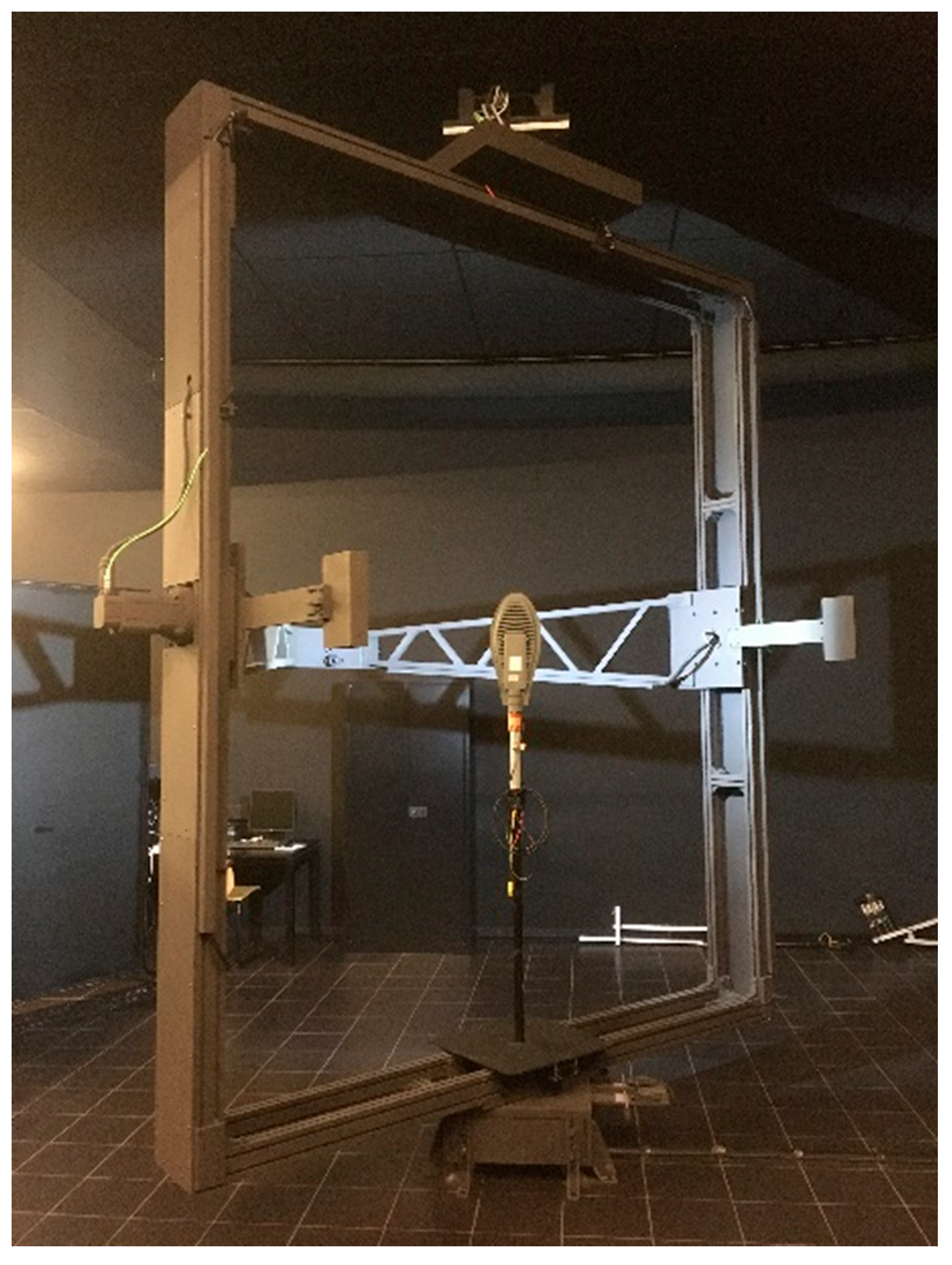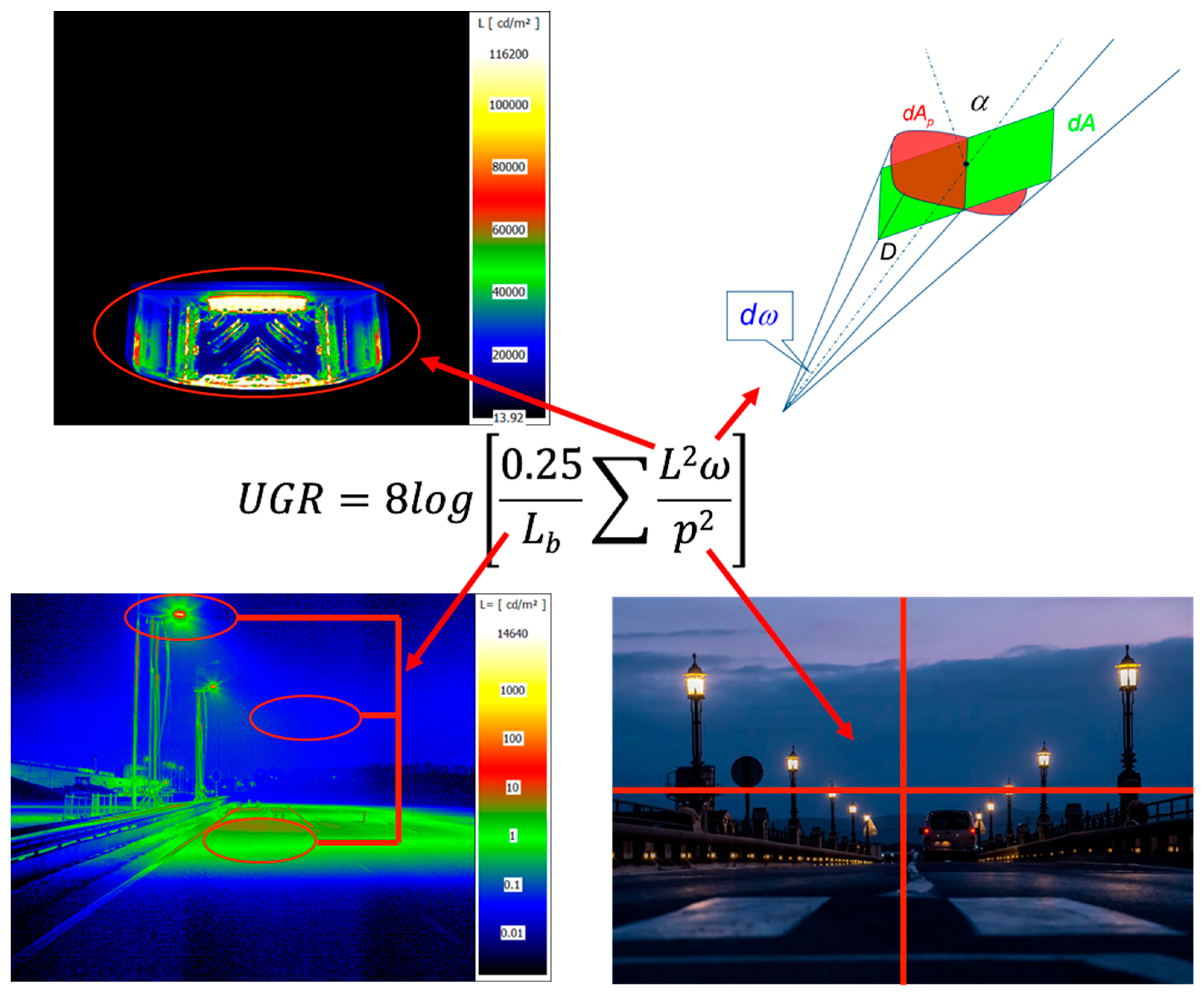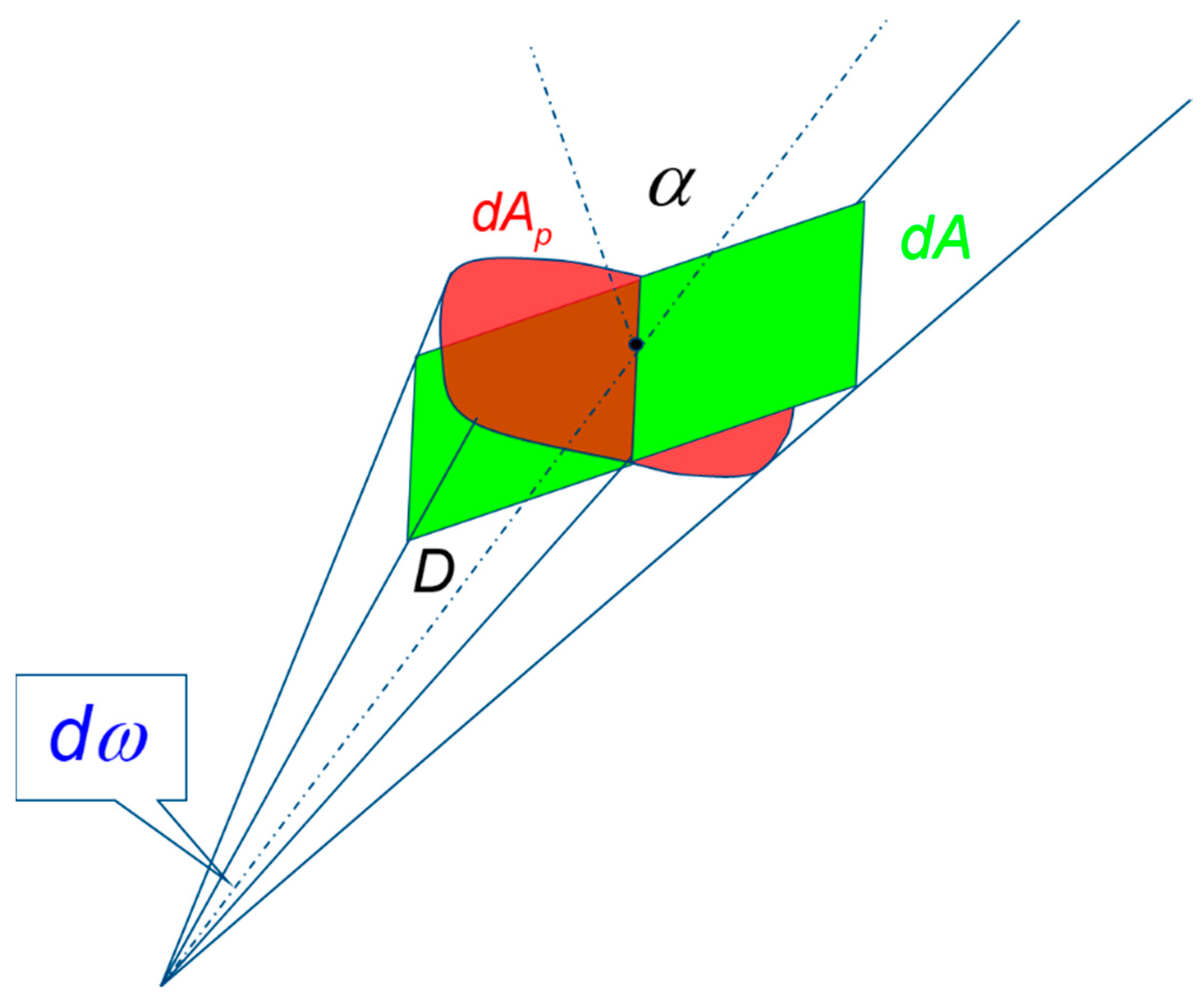Exploring the Applicability of the Unified Glare Rating for an Outdoor Non-Uniform Residential Luminaire
Abstract
1. Introduction
2. Methodology
2.1. Large Near-Field Goniophotometer (NFG)
2.2. Luminaire
2.3. Luminance Image Capture
3. Calculating UGR and UGR’
3.1. UGRLID: UGR from the Luminous Intensity Distribution
3.2. UGRimage: UGR from the Luminance Image
3.3. UGR’
4. Results and Discussion
4.1. Camera Resolution and Blurring
4.2. Viewing Angles
4.3. Background Luminance
4.4. Practical Evaluation System
5. Conclusions
Author Contributions
Funding
Institutional Review Board Statement
Informed Consent Statement
Data Availability Statement
Conflicts of Interest
References
- Commission Internationale de l’Eclairage. CIE International Lighting Vocabulary; CIE: Vienna, Austria, 1987. [Google Scholar]
- Committee on Recommendations of Quality and Quantity of Illumination of the IES. Outline of a standard procedure for computing visual comfort ratings for interior lighting. J. Illum. Eng. Soc. 1972, 2, 328. [Google Scholar]
- Illuminating Engineering Society Technical Committee. Evaluation of Discomfort Glare: The IES Glare Index System for Artificial Lighting Installations; IES Tech. Rep. 10; IES: London, UK, 1967. [Google Scholar]
- Rubino, M.; Cruz, A.; García, J.A.; Hita, E. Discomfort glare indices: A comparative study. Appl. Opt. 1994, 33, 8001–8008. [Google Scholar] [CrossRef]
- Guth, S.K. Computing visual comfort ratings for a specific interior lighting installation. Illum. Eng. 1966, 61, 634. [Google Scholar]
- Guth, S.K. A method for the evaluation of discomfort glare. Illum. Eng. 1963, 58, 351–364. [Google Scholar]
- De Boer, J.; Burghout, F.; Van Heemskerck Veeckens, J.F.T. Appraisal of the quality of public lighting based on road surface luminance and glare. In Proceedings of the 14th Session of CIE, Brussels, Belgium, 1959; pp. 529–538. [Google Scholar]
- Bennett, C.A.; Dubbert, D.; Hussain, S. Comparison of Real-World Roadway Lighting, Dynamic Simulation, CBE and Glaremark Predictive Systems; Special report no. 176; Kansas Engineering Experiment Station: Manhattan, KS, USA, 1985. [Google Scholar]
- Hopkinson, R. Glare from daylighting in buildings. Appl. Ergon. 1972, 3, 206–215. [Google Scholar] [CrossRef]
- Wienold, J.; Christoffersen, J. Evaluation methods and development of a new glare prediction model for daylight environments with the use of CCD cameras. Energy Build. 2006, 38, 743–757. [Google Scholar] [CrossRef]
- Sorensen, K. A modern glare index method. In Proceedings of the 21st CIE Session, Venice, Italy, 1987; Volume 2, p. 106. [Google Scholar]
- Commission Internationale de l’Eclairage. CIE 117:1995. Discomfort Glare in Interior Lighting; CIE: Vienna, Austria, 1995. [Google Scholar]
- European Committee for Standardisation. CEN 2011C Light and Lighting—Lighting of Work Places—Part 1: Indoor Work Places; CEN: Brussels, Belgium, 2011. [Google Scholar]
- Scheir, G.H.; Hanselaer, P.; Bracke, P.; Deconinck, G.; Ryckaert, W.R. Calculation of the Unified Glare Rating based on luminance maps for uniform and non-uniform light sources. Build. Environ. 2015, 84, 60–67. [Google Scholar] [CrossRef]
- Waters, C.; Mistrick, R.; Bernecker, C. Discomfort Glare from Sources of Nonuniform Luminance. J. Illum. Eng. Soc. 1995, 24, 73–85. [Google Scholar] [CrossRef]
- Kasahara, T.; Aizawa, D.; Irikura, T.; Moriyama, T.; Toda, M.; Iwamoto, M. Discomfort Glare Caused by White LED Light Sources. J. Light Vis. Environ. 2006, 30, 95–103. [Google Scholar] [CrossRef]
- Takahashi, H.; Irikura, T.; Moriyama, T.; Toda, M.; Iwamoto, M. Discomfort glare and annoyance caused by white LED lamps. In Proceedings of the 26th Session of the CIE, Beijing, China, 4–11 July 2007. [Google Scholar]
- Bullough, J.; Hickcox, K.S. Interactions among light source luminance, illuminance and size on discomfort glare. SAE Int. J. Passeng. Cars-Mech. Syst. 2012, 5, 199–202. [Google Scholar] [CrossRef]
- Geerdinck, L.; Van Gheluwe, J.; Vissenberg, M. Discomfort glare perception of non-uniform light sources in an office setting. J. Environ. Psychol. 2014, 39, 5–13. [Google Scholar] [CrossRef]
- Scheir, G.; Van de Perre, L.; Ryckaert, W.; Hanselaer, P. Effect of luminance contrast on the perception of discomfort. In Proceedings of the 28th CIE Session, Manchester, UK, 28 June–4 July 2015; pp. 1870–1876. [Google Scholar]
- Donners, M.A.H.; Vissenberg, M.C.J.M.; Geerdinck, L.M.; Van Den Broek-Cools, J.H.F.; Buddemeijer-Lock, A. A psychophysical model of discomfort glare in both outdoor and indoor applications. In Proceedings of the 28th CIE Session, Manchester, UK, 28 June–4 July 2015. [Google Scholar]
- Scheir, G.; Donners, M.; Geerdinck, L.; Vissenberg, M.; Hanselaer, P.; Ryckaert, W. Visual discomfort prediction based on receptive fields. In Proceedings of the CIE 2016 “Lighting Quality and Energy Efficiency”, Melbourne, Australia, 3–5 March 2016; pp. 195–203. [Google Scholar]
- Scheir, G.; Hanselaer, P.; Ryckaert, W. The effective luminous surface for the unified glare rating. In Proceedings of the 4th CIE Expert Symposium on Color and Visual Appearance, Prague, Czech Republic, 6–7 September 2016; pp. 462–469. [Google Scholar]
- Yang, Y.; Luo, R.M.; Ma, S.-N.; Liu, X.-Y. Assessing glare. Part 1: Comparing uniform and non-uniform LED luminaires. Light. Res. Technol. 2017, 49, 195–210. [Google Scholar] [CrossRef]
- Safdar, M.; Luo, M.R.; Mughal, M.F.; Kuai, S.; Yang, Y.; Fu, L.; Zhu, X. A neural response-based model to predict discomfort glare from luminance image. Light. Res. Technol. 2018, 50, 416–428. [Google Scholar] [CrossRef]
- Yang, Y.; Luo, M.R.; Ma, S. Assessing glare. Part 2: Modifying Unified Glare Rating for uniform and non-uniform LED luminaires. Light. Res. Technol. 2017, 49, 727–742. [Google Scholar] [CrossRef]
- Commission Internationale de l’Eclairage. CIE 232:2019. Discomfort Caused by Glare from Luminaires with a Non-Uniform Source Luminance; CIE: Vienna, Austria, 2019. [Google Scholar]
- Bullough, J.D.; Brons, J.; Qi, R.; Rea, M. Predicting discomfort glare from outdoor lighting installations. Light. Res. Technol. 2008, 40, 225–242. [Google Scholar] [CrossRef]
- Kohko, S.; Ayama, M.; Iwata, M.; Kyoto, N.; Toyota, T. Study on Evaluation of LED Lighting Glare in Pe-destrian Zones. J. Light Vis. Environ. 2015, 39, 15–25. [Google Scholar] [CrossRef]
- Schmidt-Clausen, H.-J.; Bindels, J.T.H. Assessment of discomfort glare in motor vehicle lighting. Light. Res. Technol. 1974, 6, 79–88. [Google Scholar] [CrossRef]
- Lin, Y.; Liu, Y.Y.; Sun, Y.; Zhu, X.; Lai, J.; Heynderickx, I.I. Model predicting discomfort glare caused by LED road lights. Opt. Express 2014, 22, 18056–18071. [Google Scholar] [CrossRef] [PubMed]
- Bodrogi, P.I.; Wolf, N.A.; Khanh, T.Q. Spectral sensitivity and additivity of discomfort glare under street and automotive lighting conditions. Light Eng. 2012, 20, 66–71. [Google Scholar]
- Sweater-Hickcox, K.; Narendran, N.; Bullough, J.D.; Freyssinier, J.P. Effect of different coloured lumi-nous surrounds on LED discomfort glare perception. Light. Res. Technol. 2013, 45, 464–475. [Google Scholar] [CrossRef]
- Commission International de l’Éclairage. CIE 243:2021. Discomfort Glare in Road Lighting and Vehicle Lighting; CIE: Vienna, Austria, 2021. [Google Scholar]
- Funke, C. Blendungsbewertung von LED-Leuchten in Innenräumen. Ph.D. Thesis, Technische Universität Ilmenau, Ilmenau, Germany, 2017. [Google Scholar]
- Villa, C.; Bremond, R.; Saint Jacques, E.; Dumont, E. Predicting the Discomfort Glare Experienced by Pedestrians: Ugr and Cbe. In Proceedings of the CIE 2017, Commission Internationale de l’Eclairage Midterm Meeting, Jeju, Korea, 20–28 October 2017; pp. 1088–1097. [Google Scholar]
- EN 13201-2:2003; Road Lighting—Part 2: Performance Requirements (BDS EN/TR 13201-2:2005—Street Lighting. Performance Requirements). European Committee for Standardisation: Brussels, Belgium, 2003.
- International Commission on Illumination; CIE Technical Committee TC-5.04. Glare Evaluation System for Use within Outdoor Sports and Area Lighting. CIE Central Bureau. 1994. Available online: http://www.cie.co.at/publications/glare-evaluation-system-use-within-outdoor-sport-and-area-lighting (accessed on 17 November 2021).
- Commission Internationale de l’Eclairage. CIE 31:1976. Discomfort Glare in Interior Lighting; CIE: Vienna, Austria, 1976. [Google Scholar]
- De Boer, J.B.; van Heemskerck Veeckens, J.F.T. Observations on discomfort glare in street lighting. In Proceedings of the CIE, Zurich, Switzerland, 1955. [Google Scholar]
- Commission Internationale de l’Eclairage. CIE 136:2000. Guide to the Lighting of Urban Areas; CIE: Vienna, Austria, 2000. [Google Scholar]
- Miller, N.J.; Koltai, R.; McGowan, T. Pedestrian Friendly Outdoor Lighting; Gateway Report PNNL-23085; Pacific Northwest National Laboratory: Portland, OR, USA, 2013. [Google Scholar]
- Miller, N.J.; McGowan, T.K. Correspondence: Glare in pedestrian-friendly outdoor lighting. Light. Res. Technol. 2015, 47, 760–762. [Google Scholar] [CrossRef]
- Spieringhs, R.M.; Phung, T.H.; Hanselaer, P. Applying the Unified Glare Rating for a non-uniform residential luminaire. In Proceedings of the 2022 Joint Conference 11th International Conference on Energy Efficiency in Domestic Appliances and Lighting (EEDAL’22) & 17th International Symposium on the Science and Technology of Lighting (LS: 17), Toulouse, France, 3 June 2022; IEEE: New York, NY, USA, 2022. [Google Scholar]
- Liu, M.; Zhang, B.; Li, W.; Guo, X.; Pan, X. Measurement and distribution of urban light pollution as day changes to night. Light. Res. Technol. 2018, 50, 616–630. [Google Scholar] [CrossRef]
- Li, Q.; Yang, G.; Yu, L.; Zhang, H. A survey of the luminance distribution in the nocturnal environment in Shanghai urban areas and the control of luminance of floodlit buildings. Light. Res. Technol. 2006, 38, 185–189. [Google Scholar] [CrossRef]
- Fotios, S.; Uttley, J.; Cheal, C.; Hara, N. Using eye-tracking to identify pedestrians’ critical visual tasks, Part 1. Dual task approach. Light. Res. Technol. 2015, 47, 133–148. [Google Scholar] [CrossRef]
- Fotios, S.; Uttley, J.; Yang, B. Using eye-tracking to identify pedestrians’ critical visual tasks. Part 2. Fixation on pedestrians. Light. Res. Technol. 2015, 47, 149–160. [Google Scholar] [CrossRef]
- Vissenberg, M.C.J.M.; Perz, M.; Donners, M.A.H.; Sekulovski, D. A generic glare sensation model based on the human visual system. In Proceedings of the CIE 2021, Kuala Lumpur, Malaysia, 27–29 September 2021; pp. 203–212. [Google Scholar] [CrossRef]
- Scheir, G.; Hanselaer, P.; Ryckaert, W. Pupillary light reflex, receptive field mechanism and correction for retinal position for the assessment of visual discomfort. Light. Res. Technol. 2019, 51, 291–303. [Google Scholar] [CrossRef]
- Donners MA, H.; Vissenberg MC, J.M.; Geerdinck, L.M.; Van Den Broek-Cools JH, F.; Buddemeijer-Lock, A. A psychophysical model of discomfort glare for both indoor and outdoor applications. In Proceedings of the CIE x042:2016 “Lighting Quality and Energy Efficiency”, Melbourne, Australia, March 2016; pp. 142–151. [Google Scholar]







| 0.00645 | |
|---|---|
| Focal length lens f (mm) | 6.5 |
| 9.85 × 10−7 | |
| Measurement distance D (mm) | 1540 |
| (mm) | 1.528 |
| (cd/m2) used in the UGR calculations | 1 |
| Guth index γ = 50 | 5.391 |
| Guth index γ = 65 | 2.689 |
| Orientation | ||||
|---|---|---|---|---|
| C = 0 γ = 50 | C = 0 γ = 65 | C = 90 γ = 50 | C = 90 γ = 65 | |
| UGR’ | 29.0 (−10.2%) | 31.3 (−9.0%) | 24.0 (−8.0%) | 28.2 (−5.4%) |
| UGRimage | 28.8 (−10.8%) | 31.5 (−8.4%) | 22.9 (−12.3%) | 27.5 (−7.7%) |
| UGRLID | 32.3 | 34.4 | 26.1 | 29.8 |
| Orientation | ||||
|---|---|---|---|---|
| C = 0 γ = 50 | C = 0 γ = 65 | C = 90 γ = 50 | C = 90 γ = 65 | |
| UGR’ (12 mm/pixel blurring) | 29.0 | 31.3 | 24.0 | 28.2 |
| UGR’ (20 mm/pixel blurring) | 28.6 (−1.4%) | 30.9 (−1.3%) | 23.5 (−2.1%) | 27.7 (−1.8%) |
| Orientation | |||||
|---|---|---|---|---|---|
| C = 0 γ = 50 | C = 0 γ = 65 | C = 90 γ = 50 | C = 90 γ = 65 | C = 15 γ = 75 | |
| UGR’ | 29.0 (−10.2%) | 31.3 (−9.0%) | 24.0 (−8.0%) | 28.2 (−5.4%) | 47.0 (19.9%) |
| UGRimage | 28.8 (−10.8%) | 31.5 (−8.4%) | 22.9 (−12.3%) | 27.5 (−7.7%) | 53.5 (36.5%) |
| UGRLID | 32.3 | 34.4 | 26.1 | 29.8 | 39.2 |
| Lb = 0.5 cd/m2 | ||||
|---|---|---|---|---|
| Orientation | ||||
| C = 0 γ = 50 | C = 0 γ = 65 | C = 90 γ = 50 | C = 90 γ = 65 | |
| UGR’ | 31.4 (8.3%) | 33.7 (7.7%) | 26.4 (10.0%) | 30.6 (8.5%) |
| UGRimage | 31.2 (8.3%) | 33.9 (7.6%) | 25.3 (10.5%) | 29.9 (8.7%) |
| UGRLID | 34.7 (7.4%) | 36.8 (7.0%) | 28.5 (9.2%) | 32.2 (8.1%) |
| Lb = 0.05 cd/m2 | ||||
| UGR’ | 39.4 (35.9%) | 41.7 (33.2%) | 34.4 (43.3%) | 38.6 (36.9%) |
| UGRimage | 39.2 (36.1%) | 41.9 (33.0%) | 33.3 (45.4%) | 37.9 (37.8%) |
| UGRLID | 42.7 (32.2%) | 44.8 (30.2%) | 36.5 (39.8%) | 40.2 (34.9%) |
| Orientation | ||||
|---|---|---|---|---|
| C = 0 γ = 50 | C = 0 γ = 65 | C = 90 γ = 50 | C = 90 γ = 65 | |
| VD | 4.2 | 3.8 | 3.5 | 3.3 |
Publisher’s Note: MDPI stays neutral with regard to jurisdictional claims in published maps and institutional affiliations. |
© 2022 by the authors. Licensee MDPI, Basel, Switzerland. This article is an open access article distributed under the terms and conditions of the Creative Commons Attribution (CC BY) license (https://creativecommons.org/licenses/by/4.0/).
Share and Cite
Spieringhs, R.M.; Phung, T.H.; Audenaert, J.; Hanselaer, P. Exploring the Applicability of the Unified Glare Rating for an Outdoor Non-Uniform Residential Luminaire. Sustainability 2022, 14, 13199. https://doi.org/10.3390/su142013199
Spieringhs RM, Phung TH, Audenaert J, Hanselaer P. Exploring the Applicability of the Unified Glare Rating for an Outdoor Non-Uniform Residential Luminaire. Sustainability. 2022; 14(20):13199. https://doi.org/10.3390/su142013199
Chicago/Turabian StyleSpieringhs, Rik Marco, Thanh Hang Phung, Jan Audenaert, and Peter Hanselaer. 2022. "Exploring the Applicability of the Unified Glare Rating for an Outdoor Non-Uniform Residential Luminaire" Sustainability 14, no. 20: 13199. https://doi.org/10.3390/su142013199
APA StyleSpieringhs, R. M., Phung, T. H., Audenaert, J., & Hanselaer, P. (2022). Exploring the Applicability of the Unified Glare Rating for an Outdoor Non-Uniform Residential Luminaire. Sustainability, 14(20), 13199. https://doi.org/10.3390/su142013199







